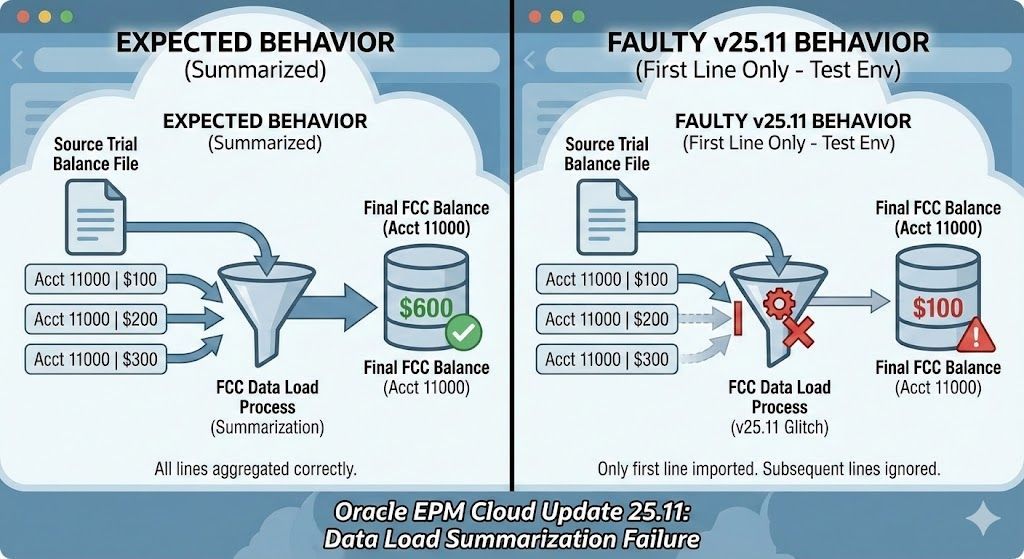Oracle ARCS: Format Rules vs. Profile Rules
Nadia Lodroman • 29 April 2025
Listen to Tresora and Ledgeron's chatting about this blog post:
Format vs. Profile: Mastering Rules in Oracle ARCS
Navigating the world of reconciliation in Oracle ARCS (Account Reconciliation Cloud Service) involves understanding how to effectively leverage rules. A key decision you'll face is whether to configure these rules at the format level
or the profile level. While both approaches allow you to automate and streamline your reconciliation processes, they cater to different needs and offer distinct advantages. Let's delve into the nuances of each.
Rules at the Format Level: A Template for Consistency
Think of format-level rules as blueprints applied to all reconciliations using a specific format. When you define a rule at this level, it automatically applies to every profile associated with that particular format.
Key Characteristics:
- Global Application: Changes to a format-level rule impact all profiles using that format.
- Standardisation: Enforces consistent reconciliation logic across similar account types.
- Efficiency for Common Logic: Ideal for applying standard matching criteria or balance explanations to a group of accounts.
- Centralised Maintenance: Updates and modifications are managed in one place, simplifying administration.
Rules at the Profile Level: Tailoring to Specific Needs
Profile-level rules, on the other hand, offer a more granular approach. These rules are defined and applied specifically to individual reconciliation profiles.
Key Characteristics:
- Targeted Application: Rules are unique to a specific profile and do not affect others.
- Flexibility: Allows for customised logic to address the unique characteristics of individual accounts.
- Handling Exceptions: Useful for accounts with specific reconciliation requirements or complex matching scenarios.
- Independent Management: Each profile's rules are managed separately.
Consider a complex intercompany reconciliation. Due to the unique nature of these transactions and potential currency differences, you might need a profile-level rule with specific tolerance levels that differ from your standard formats.
When to Choose Which?
The decision to use format-level or profile-level rules hinges on the degree of standardisation and customisation your reconciliation process requires.
When both format and profile rules are present, it's important to understand the order in which they are applied.
- Generally, format rules are executed first.
- Successfully executing a rule in Oracle Account Reconciliation may prevent a later rule from being invoked.
Opt for Format-Level Rules When:
- You have a group of accounts that follow the same reconciliation logic.
- Consistency and standardization are paramount.
- You want to efficiently manage and update common rules across multiple profiles.
Opt for Profile-Level Rules When:
- An individual account has unique reconciliation requirements.
- You need highly specific matching criteria or balance explanations.
- The account involves complex transactions or data sources.
- You need to implement exceptions or deviations from standard processes.
A Hybrid Approach:
It's important to note that you can effectively combine both approaches. You might establish baseline rules at the format level for common scenarios and then add specific profile-level rules to handle exceptions or unique situations. This hybrid strategy allows you to leverage the efficiency of format-level rules while retaining the flexibility to address individual account complexities.
Best Practices:
- Analyse your reconciliation processes: Understand the commonalities and differences across your accounts.
- Start with standardisation: Where possible, utilise format-level rules to promote consistency.
- Reserve profile-level rules for exceptions: Avoid creating unnecessary profile-level rules for accounts that can be managed at the format level.
- Document your rule logic: Clearly document the purpose and configuration of both format and profile-level rules for auditability and maintainability.
- Regularly review your rules: Ensure your rules remain relevant and effective as your business processes evolve.
By understanding the strengths and applications of both format-level and profile-level rules in Oracle ARCS, you can strategically design your reconciliation processes for optimal efficiency, accuracy, and control. Choosing the right approach, or a thoughtful combination of both, will empower you to master your reconciliations and gain greater confidence in your financial data.






